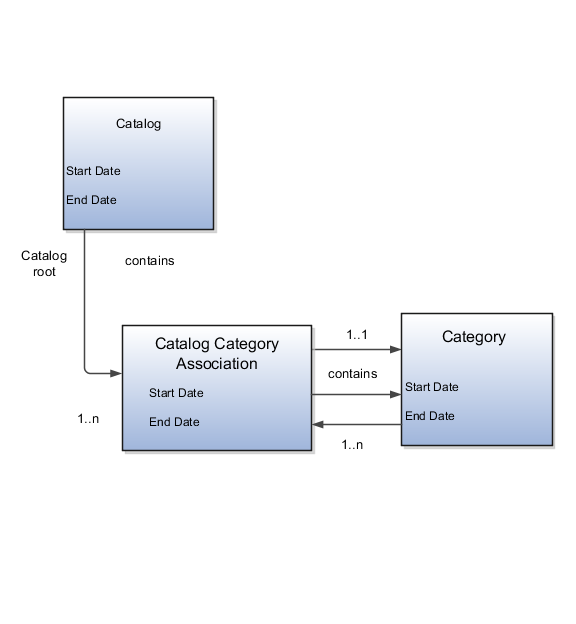Date Enablement for Catalogs and Categories
The catalog, categories, and catalog category association use date enablement to determine if the object specified is active or inactive based on the start date and end date. The following are date enablement definitions:
-
Active: An object is active when the current date is later than or equal to the value of the start date, but earlier than or equal to value of the end date.
-
Inactive: An object is inactive when the current date is later than the value of the end date.
-
Future dated: An object is future dated when the current date is earlier than the value of the start date.
You set the date enablement attributes are used to determine when a catalog, category, or catalog category association is used or visible.
-
On the Manage Catalog page, a table filter determines which catalogs appear. The default value for the choice list is Active, indicating that only active catalogs will be displayed. You can select the value All to view both active and inactive catalogs.
-
On the Edit Catalog page, on the category hierarchy tab, two table filters determine what categories and catalog category associations appear. The default values for the two choice lists are Active, indicating that only active categories and active catalog category associations will be displayed. You can select the value All to view both active and inactive categories and catalog categories associations.
-
Other applications also use the date enablement attributes to filter information retrieved through application programming interfaces or services for catalogs.
The following figure provides the date enablement attributes for these objects. The catalog, category, or the catalog category association has an internal state that is active or inactive.

The following aspects are important regarding date enablement for catalogs and categories:
-
Start date
-
End date
-
Catalog and category objects
-
Catalog category association
-
Catalog and category rules
Start Date
The start date is defined as the first date that the object can be active. The start date can be future dated by setting the value to a date later than the current date. The start date value defaults to the system date if no date is entered during catalog or category creation.
End Date
The end date is defined as the last date that the object can be active. The object is end dated one second after the date specified by the value of End Date, that is the next day at 12:00:01 a.m. You cannot set the end date in the past. Also, you can change the end date from a condition when the object is ended to a new end date greater than or equal to the system date, causing the object to go from inactive to active. The end date value is optional during catalog or category creation.
Catalog and Category Objects
The start and end dates have been added for the catalog and catalog category association. The inactive date for categories has been renamed as the end date and the start date has been added.
Catalog Category Association
The catalog category association is used to specify the parent and child relationships between catalogs and categories and for category to category relationships. The catalog category association date enablement is independent of the category data enablement, except for the case where the category is end dated; the association is ended automatically as well. The catalog category association dates represents the state of the category for the catalog in which the category is associated.
Catalog and Category Rules
When a catalog is inactive the following rules apply:
-
All operations for the catalog are disabled; the catalog can be edited.
-
The catalog cannot be used in other processes.
-
The catalog can be viewed only if you set filters on the Manage Catalog page to a value of All, enabling you to view active and inactive catalogs.
When a category is inactive the following rules apply:
-
All operations for the category are disabled; the category is not able to be edited.
-
The category cannot be added to other catalogs.
-
The category can be viewed only if you set the filters on the Edit Catalog page to a value of All, enabling you to view active and inactive catalogs.
-
The application sets the catalog category association for the inactive category to inactive.
When a catalog category association is inactive the following rules apply:
-
The category may be inactive or active; if the category is active it can be edited.
-
The catalog category associations and related category can be viewed only if you set the association filter on the Edit Catalog page to a value of All, enabling you to view active and inactive catalogs.
When a catalog is future dated the following rules apply:
-
All the operations of the catalog are enabled and the catalog is can be edited.
-
The catalog can be used in other processes, if allowed.
-
The catalog can be viewed only if the you set the filters on the Manage Catalog page to a value of All.